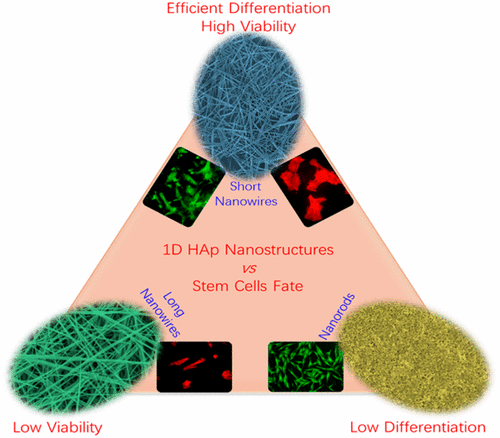当前位置:
X-MOL 学术
›
ACS Appl. Mater. Interfaces
›
论文详情
Our official English website, www.x-mol.net, welcomes your
feedback! (Note: you will need to create a separate account there.)
One-Dimensional Hydroxyapatite Nanostructures with Tunable Length for Efficient Stem Cell Differentiation Regulation
ACS Applied Materials & Interfaces ( IF 8.3 ) Pub Date : 2017-09-22 00:00:00 , DOI: 10.1021/acsami.7b13313 Baojin Ma , Shan Zhang , Feng Liu , Jiazhi Duan , Shicai Wang , Jing Han , Yuanhua Sang , Xiaoqiang Yu , Dong Li 1 , Wei Tang , Shaohua Ge , Hong Liu 2
ACS Applied Materials & Interfaces ( IF 8.3 ) Pub Date : 2017-09-22 00:00:00 , DOI: 10.1021/acsami.7b13313 Baojin Ma , Shan Zhang , Feng Liu , Jiazhi Duan , Shicai Wang , Jing Han , Yuanhua Sang , Xiaoqiang Yu , Dong Li 1 , Wei Tang , Shaohua Ge , Hong Liu 2
Affiliation

|
It is well-accepted that most osteogenic differentiation processes do need growth factors assistance to improve efficiency. As a material cue, hydroxyapatite (HAp) can promote osteogenic differentiation of stem cells only in a way. Up to now, rare work related to the relationship between HAp nanostructures and stem cells in osteogenic differentiation process without the assistance of growth factors has been reported. In this study, one-dimensional (1D) HAp nanostructures with tunable length were synthesized by an oleic acid assisted solvothermal method by adjusting the alcohol/water ratio (η). The morphology of 1D HAp nanostructures can be changed from long nanowires into nanorods with the η value change. Different substrates constructed by 1D HAp nanostructures were prepared to investigate the effect of morphology of nanostructured HAp on stem cell fate without any growth factors or differentiation induce media. Human adipose-derived stem cells (hADSCs), a kind of promising stem cell for autologous stem cell tissue engineering, were used as the stem cell model. The experiments prove that HAp morphology can determine the performance of hADSCs cultured on different substrates. Substrate constructed by HAp nanorods (100 nm) is of little benefit to osteogenic differentiations. Substrate constructed on HAp long nanowires (50 μm) causes growth and spread inhibition of hADSCs, which even causes most cells death after 7 days of culture. However, substrate constructed by HAp short nanowires (5 μm) can destine the hADSCs differentiation to osteoblasts efficiently in normal medium (after 3 weeks) without any growth factors. It is surprise that hADSCs have changed to polyhedral morphology and exhibited the tendency to osteogenic differentiation after only 24 h culture. Hydroxyapatite nanostructures mediated stem cell osteogenic differentiation excluding growth factors provides a powerful cue to design biomaterials with special nanostructures, and helps to elucidate the interaction of stem cell and biomaterials nanostructures. The results from this study are promising for application in bone tissue engineering.
中文翻译:

一维长度可调的羟基磷灰石纳米结构用于有效的干细胞分化调控。
公认的是,大多数成骨细胞分化过程确实需要生长因子辅助来提高效率。作为物质线索,羟磷灰石(HAp)只能以某种方式促进干细胞的成骨分化。迄今为止,已经报道了在没有生长因子帮助的情况下,在成骨分化过程中与HAp纳米结构和干细胞之间的关系有关的罕见工作。在这项研究中,通过调节醇/水比(η),通过油酸辅助溶剂热法合成了具有可调长度的一维(1D)HAp纳米结构。一维HAp纳米结构的形态可以随η值的变化从长纳米线变为纳米棒。制备了由一维HAp纳米结构构建的不同底物,以研究纳米结构HAp的形态对干细胞命运的影响,而没有任何生长因子或分化诱导培养基。人类脂肪干细胞(hADSCs)是一种用于自体干细胞组织工程的有前途的干细胞,被用作干细胞模型。实验证明,HAp形态可以决定在不同底物上培养的hADSC的性能。由HAp纳米棒(100 nm)构建的底物对成骨分化几乎没有益处。在HAp长纳米线(50μm)上构建的底物引起hADSC的生长和扩散抑制,甚至在培养7天后甚至导致大多数细胞死亡。然而,由HAp短纳米线(5μm)构建的底物可以在没有任何生长因子的情况下,在正常培养基中(3周后)有效地确定hADSCs向成骨细胞的分化。令人惊讶的是,hADSCs仅在培养24小时后便已转变为多面体形态,并表现出成骨分化的趋势。排除生长因子的羟基磷灰石纳米结构介导的干细胞成骨分化为设计具有特殊纳米结构的生物材料提供了强有力的提示,并有助于阐明干细胞与生物材料纳米结构的相互作用。这项研究的结果有望用于骨组织工程。令人惊讶的是,hADSCs仅在培养24小时后便已转变为多面体形态,并表现出成骨分化的趋势。排除生长因子的羟基磷灰石纳米结构介导的干细胞成骨分化为设计具有特殊纳米结构的生物材料提供了强有力的提示,并有助于阐明干细胞与生物材料纳米结构的相互作用。这项研究的结果有望用于骨组织工程。令人惊讶的是,hADSCs仅在培养24小时后便已转变为多面体形态,并表现出成骨分化的趋势。排除生长因子的羟基磷灰石纳米结构介导的干细胞成骨分化为设计具有特殊纳米结构的生物材料提供了强有力的提示,并有助于阐明干细胞与生物材料纳米结构的相互作用。这项研究的结果有望用于骨组织工程。
更新日期:2017-09-23
中文翻译:

一维长度可调的羟基磷灰石纳米结构用于有效的干细胞分化调控。
公认的是,大多数成骨细胞分化过程确实需要生长因子辅助来提高效率。作为物质线索,羟磷灰石(HAp)只能以某种方式促进干细胞的成骨分化。迄今为止,已经报道了在没有生长因子帮助的情况下,在成骨分化过程中与HAp纳米结构和干细胞之间的关系有关的罕见工作。在这项研究中,通过调节醇/水比(η),通过油酸辅助溶剂热法合成了具有可调长度的一维(1D)HAp纳米结构。一维HAp纳米结构的形态可以随η值的变化从长纳米线变为纳米棒。制备了由一维HAp纳米结构构建的不同底物,以研究纳米结构HAp的形态对干细胞命运的影响,而没有任何生长因子或分化诱导培养基。人类脂肪干细胞(hADSCs)是一种用于自体干细胞组织工程的有前途的干细胞,被用作干细胞模型。实验证明,HAp形态可以决定在不同底物上培养的hADSC的性能。由HAp纳米棒(100 nm)构建的底物对成骨分化几乎没有益处。在HAp长纳米线(50μm)上构建的底物引起hADSC的生长和扩散抑制,甚至在培养7天后甚至导致大多数细胞死亡。然而,由HAp短纳米线(5μm)构建的底物可以在没有任何生长因子的情况下,在正常培养基中(3周后)有效地确定hADSCs向成骨细胞的分化。令人惊讶的是,hADSCs仅在培养24小时后便已转变为多面体形态,并表现出成骨分化的趋势。排除生长因子的羟基磷灰石纳米结构介导的干细胞成骨分化为设计具有特殊纳米结构的生物材料提供了强有力的提示,并有助于阐明干细胞与生物材料纳米结构的相互作用。这项研究的结果有望用于骨组织工程。令人惊讶的是,hADSCs仅在培养24小时后便已转变为多面体形态,并表现出成骨分化的趋势。排除生长因子的羟基磷灰石纳米结构介导的干细胞成骨分化为设计具有特殊纳米结构的生物材料提供了强有力的提示,并有助于阐明干细胞与生物材料纳米结构的相互作用。这项研究的结果有望用于骨组织工程。令人惊讶的是,hADSCs仅在培养24小时后便已转变为多面体形态,并表现出成骨分化的趋势。排除生长因子的羟基磷灰石纳米结构介导的干细胞成骨分化为设计具有特殊纳米结构的生物材料提供了强有力的提示,并有助于阐明干细胞与生物材料纳米结构的相互作用。这项研究的结果有望用于骨组织工程。











































 京公网安备 11010802027423号
京公网安备 11010802027423号